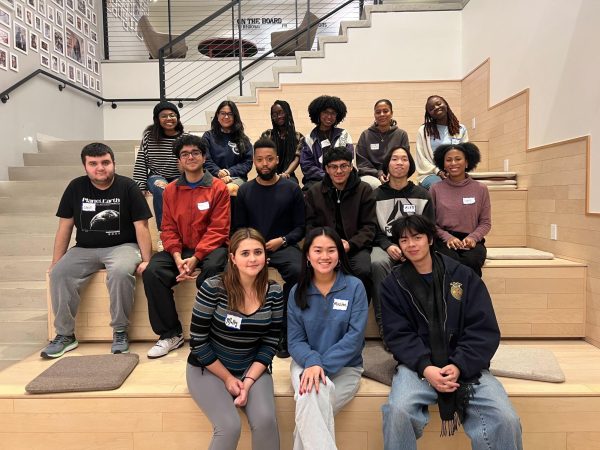New York City is the world’s media capital, home to the most authoritative sources of global journalism including The New York Times, The Wall Street Journal, CNN and The Associated Press. The city boasts five major daily papers and 116 neighborhood media outlets. Ours is a city brimming with media in every form.
Yet our diverse, wealthy, and media-saturated city is a virtual news desert when it comes to youth journalism. Only a quarter of New York City’s public high schools have a news publication, whether they are digital or print, a journalism class or club, or a magazine or newspaper.
As New York educates a rising generation to navigate a media-saturated landscape, sort fact from falsehood, and exercise the responsibilities of democratic citizenship, an investment in student journalism is a downpayment on a thriving future for our city.
Journalism and news literacy are increasingly recognized as underpinnings of a well-functioning democracy. The Wall Street Journal found that 80% of Gen Z teens primarily rely on social media for their news and information.
While Gen-Z may be dubbed a generation of “change-makers” and activists, many young people are ill-equipped to distinguish crucial facts from discredited conspiracy theories. In August 2023, The Center for Countering Digital Hate found that 60% of 13-17-year-old Americans agreed with four or more harmful conspiracy statements. Ill-informed students mature into gullible grown-ups; 40% of adults bought into the same claims.
In any realm, from the climate movement to LGBTQ+ rights to wars overseas, young people will be powerless to create positive change if they cannot discern what is true. For young people to understand what they are reading, know what sources of information to trust, follow their curiosities, and form well-informed beliefs, they first need a basic understanding of what journalism is and how it is done.
Teenagers gleaning most of their news from TikTok need to be able to tell the difference between a credible, reported story by a mainstream journalism outlet and ideological propaganda published by an influencer known for “hot takes” who profits from each viral video. Whether young people are deciding who to vote for, where to work, or how to protect themselves from a health threat, they desperately need to understand what up-to-the-minute information they can rely on.
A working understanding of journalism provides this foundation, offering students insight into how journalists back up their claims, what sources they rely on, and how their reporting is vetted by editors before it reaches the general public. It teaches students that all subjects, including the causes they rally for, are nuanced and complex and a variety of information should support any stance they take.
Across the country, there is growing recognition of the link between trustworthy news and a healthy society. In recent decades almost a third of local news outlets have shuttered, while the remainder have drastically slashed their reporting staff. The demise of local news has been suggested as an important culprit as civic leaders attempt to understand current political polarization, government dysfunction, and distrust in institutions. If communities lack a shared source of facts, how can they be expected to agree on who to elect or what policies to support? As a result, hundreds of millions of dollars have been mobilized to bolster local news nationwide, investing to keep city papers alive and fund innovative new journalism outlets.
As America wakes up to the essential role of journalism as a building block for democracy, it is crucial to engage students who will form the next generation of newsmakers, news reporters, and news consumers.
Student journalism provides an array of tangible benefits to young people. By gaining skills in reporting, writing, and editing, students are set up for professional success in a wide range of fields. The opportunity to work on a newspaper or publication teaches soon-to-be college students crucial lessons including approaching a topic with objectivity, verifying information, writing to diverse audiences, and including a range of perspectives. Student journalists also learn to use words responsibly, knowing that their stories and columns will remain a permanent part of their digital footprint.
Over the last year college journalists have broken stories and championed reporting on some of the most consequential higher education stories of our time, including the ousting of Stanford University’s president for research fraud and the controversy over Harvard President Claudine Gay’s Congressional testimony about antisemitism and plagiarism. Students with bylines on these stories read around the world will have their pick of journalism jobs once they graduate.
Skills associated with journalism and news publications go well beyond reporting, writing, and editing. Photography, graphic design, art, marketing and cartooning can all contribute to compelling student news outlets.
Taking part in journalism is empowering. Students learn to follow their own interests, to write and report stories that can amplify lesser-heard opinions, and even spark a larger conversation and enact change.
As a student journalist in middle school, I wrote a series on vaping during my fifth grade year, after I began to notice the older kids in my school vaping in the bathroom or on street corners. The articles helped raise student awareness of the health consequences of vapes and prompted the school to get serious about enforcing policies that prohibited it. The topic was controversial and I had to think carefully about how to present it in a way that wouldn’t simply make the students who vaped feel exposed and resentful. Taking part in journalism teaches skills in how to handle controversial and loaded topics delicately and fairly.
For students who often feel they lack any say over how their schools are run, journalism can offer a vehicle to drive forward change. Another article in my middle school paper looked at disparities in the role played by girls and boys in group work, spotlighting how teachers would lean on hard-working girls to lead teams and allow slackers to free ride on their efforts. The story prompted a change in how groups were assigned, and greater follow-up by teachers to make sure everyone was pulling their weight.
By providing a shared base of information and ideas student journalism outlets can also foster a sense of community that unites diverse, city-wide student bodies and provides a counterweight to the polarizing effects of social media. City high schools, for the most part, don’t have football teams or pep rallies, so newspapers can be a venue to build excitement about events and to celebrate accomplishments and talents in art, writing, humor, or photography.
Greater investment in student media in New York City would also pay dividends for the journalism profession. A study by Baruch College journalism professor Geanne Belton found that more than three-quarters of city schools with the highest percentage of white and Asian students have newspapers, compared to just 8% of schools with majority Black populations and 16% with majority Latino student bodies.
The disparities in access to journalism in city schools are mirrored in the field writ large. A 2022 Pew Research Center study revealed over 76% of current professional journalists are white; efforts to diversify newsrooms have stalled with goals unfulfilled. These gaps distort news coverage and can leave disadvantaged communities out of the story.
Wider access to student journalism programs in New York City could create a pipeline for talented people from all backgrounds to enter the profession and become the next generation of journalists. With its large population of working journalists, many of whom remain in the city once they retire, the city is sitting on a pool of accomplished professionals who could offer mentoring and guidance to build a more inclusive generation of journalists.
Journalists and activists in the city are coming to recognize that student journalism is essential and demands attention and investment. Non-profit organizations such as Press Pass, The Bell, and the Youth Journalism Coalition offer workshops for students and teachers alike aimed at kickstarting publications at individual schools. To bring these efforts to the next level, the Department of Education should prioritize student journalism for funding and staffing, making opportunities available to more schools and students.

Advocates, recognizing the hurdles to creating sustainable school-based journalism programs, should join forces to explore the possibilities for a city-wide student newspaper to give opportunities to those who lack offerings at their own schools. A strong citywide journalism program, comparable to offerings that exist for debate or sports, could also help seed greater interest at the level of individual schools.
The future of American democracy depends upon a rising generation of civic future.
Wider access to student journalism programs in New York City could create a pipeline for talented people from all backgrounds to enter the profession and become the next generation of journalists.

